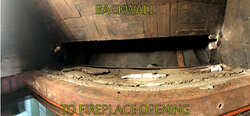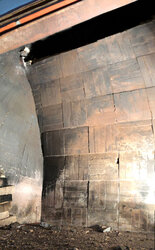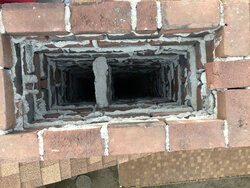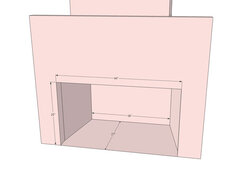New member and first post. I have been working towards relining my chimney for several months now and was excited to find this site today. I'll dig right in...
We have a historic home built in 1910 with an original wood burning brick fireplace that was converted to gas about 20 years ago, and we are looking to go back to wood burning without an insert. Had several inspections done on it a few years back to learn that most of the mortar liner has warn off the inside of the flue. Received quotes ranging from $12k to $18k to reline using various methods as it is a double flue liner. Being a capable DIYer, I decided I could tack it myself.
The details: Fireplace opening is 44" wide by 25" high (1100 in/sq.) and we are using two 7.5" square, flexible 316Ti liners (112.5 in.sq. area) running 23' to the top of the Chimney. Bottom plates will be mesh and using two top-sealing dampers inside a dual-flue cap.
Looking for some some additional guidance and wisdom for a few questions I have found mixed answers to on all the "pro" websites:
#1 - I am in the process of removing several rows of brick where the back wall juts out to the smoke shelf so that I can feed the liners up into the flue. I found about 4 inches of sand and debris resting on the smoke shelf, even after the fireplace was cleaned twice. I believe the issue was that the smoke shelf was so deep that it was hard for the chimney sweeps to get a vacuum up into the smoke shelf area due to a narrow opening. Does a fireplace need a smoke shelf? If so, how large should the opening be from the Fire Box to the Smoke Chamber? Same ratio as the flue to fireplace opening? Here is a photo for visual reference, shown after I already removed roughly 4" of horizontally stacked brick at the top of the back wall.

#2 - I am going with a poured insulation and was planning on trimming the liners just above the chimney and then using Type N Mortar to seal the top creating a slight dome. Would that be acceptable or do I need to use refractory mortar up there as well?
Here are a few more photos for reference.



We have a historic home built in 1910 with an original wood burning brick fireplace that was converted to gas about 20 years ago, and we are looking to go back to wood burning without an insert. Had several inspections done on it a few years back to learn that most of the mortar liner has warn off the inside of the flue. Received quotes ranging from $12k to $18k to reline using various methods as it is a double flue liner. Being a capable DIYer, I decided I could tack it myself.
The details: Fireplace opening is 44" wide by 25" high (1100 in/sq.) and we are using two 7.5" square, flexible 316Ti liners (112.5 in.sq. area) running 23' to the top of the Chimney. Bottom plates will be mesh and using two top-sealing dampers inside a dual-flue cap.
Looking for some some additional guidance and wisdom for a few questions I have found mixed answers to on all the "pro" websites:
#1 - I am in the process of removing several rows of brick where the back wall juts out to the smoke shelf so that I can feed the liners up into the flue. I found about 4 inches of sand and debris resting on the smoke shelf, even after the fireplace was cleaned twice. I believe the issue was that the smoke shelf was so deep that it was hard for the chimney sweeps to get a vacuum up into the smoke shelf area due to a narrow opening. Does a fireplace need a smoke shelf? If so, how large should the opening be from the Fire Box to the Smoke Chamber? Same ratio as the flue to fireplace opening? Here is a photo for visual reference, shown after I already removed roughly 4" of horizontally stacked brick at the top of the back wall.

#2 - I am going with a poured insulation and was planning on trimming the liners just above the chimney and then using Type N Mortar to seal the top creating a slight dome. Would that be acceptable or do I need to use refractory mortar up there as well?
Here are a few more photos for reference.



Last edited by a moderator:


